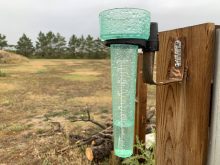A booster shot of rain falling across southern Alberta and the last major irrigation district closing its canal will buoy dwindling reservoir and river levels as the first week of October ends.
But the short-term forecast will see a return of warm, dry conditions and the seasonal forecast is unclear, though El Nino is expected to deliver low precipitation.
The potential effects of continued warm, dry conditions were outlined in an Aug. 28 letter from Alberta’s deputy minister of agriculture to the heads of 11 irrigation districts. It warned of “dire” consequences for next season if normal amounts of spring snowmelt aren’t received.
Read Also

Feds propose overhaul of chronic wasting disease control program
Chronic Wasting disease control program getting updated by Canadian Food Inspection Agency with feedback encouraged from producers.
Irrigation districts were able to manage this season, which saw less than normal mountain runoff followed by scorching temperatures and minimal precipitation. But not without some of them struggling to get through September.
It’s not just southern Alberta irrigators feeling the pinch.
“It’s been since mid-June, first of July since we’ve been hauling water,” said rancher Kent Holowath who operates a cow-calf operation near Rumsey, Alta.
He hauled water at the start to keep his cattle from damaging dugouts and overgrazing the surrounding pasture. But by the end of the summer, it was because the dugouts were empty.
Holowath said normally his dugouts don’t dry out at all.
The exception was 2002 and 2003 when the region southeast of Red Deer was experiencing drought.
The water shortage advisory for his area, one of 41 in place in Alberta, was issued June 16.
Of the current advisories, the Sheep River’s along with the Nose and Fish creek’s stretch back to late August 2022.
The latest advisories were issued in September for areas around Medicine Hat and the South Saskatchewan River with water management regions draining into the Bow, Oldman and North Saskatchewan basins being alerted throughout the summer of the deteriorating conditions
The beginning of October has seen conditions improve slightly, according to Nathalie Brunet, Alberta Environment river forecast engineer.
A little more than 25 percent of the measured rivers and creeks in the Oldman basin are below the lowest quarter of historical averages while more than three-quarters total are in the bottom half.
In the Bow basin, nearly 60 percent are below the lowest quarter of historical averages while 85 percent total are in the bottom half.
“That’s an improvement,” said Brunet.
Alberta is currently in Stage 4 of its five-stage water shortage management alert system.
Stage 5 would see an emergency declaration under the Alberta Water Act.
Lethbridge Northern Irrigation District is the last remaining irrigator operating this year with it set to shut down on Oct. 6.
Contact alex.mccuaig@producer.com
















